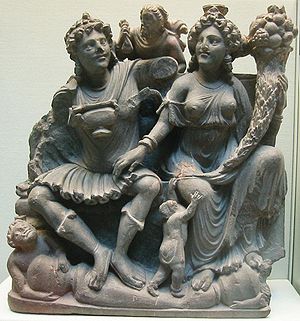- Hārītī
-
Pancika et Hārītī (à droite), tenant une corne d'abondance ; leurs pieds reposent sur un sac d'abondance. IIIe siècle, Takht-i-Bahi, Gandhara, British Museum.

Hārītī (en sanscrit) ou Kishimojin, 鬼子母神, (en japonais) est une déesse du bouddhisme pour la protection des enfants, les accouchements sans complication et l'harmonie générale de la famille.
Selon une légende, rapportée au VIIe siècle par le voyageur chinois I-tsing, Hārītī était une ogresse s'adonnant au cannibalisme pour nourrir ses très nombreux enfants. C'est après avoir rencontré le Bouddha qu'elle se repentit et protégea les enfants. Hārītī, preneuse d'enfants est la déesse de la variole, maladie qui frappait particulièrement les jeunes enfants[1].
Elle est associée à la déesse Kâlî de l'hindouisme. Dans la culture de Gandhara, Hārītī a des attributs de la déesse grecque Tyché, dont les vêtements et la corne d'abondance.
Sommaire
Autres noms
- Kangimo (japonais : 歓喜母, « qui amène le bohneur »)
- Karitei (japonais : 訶利帝, nom Shingon)
- Kariteimo (japonais : 訶梨帝母, autre nom Shingon)
- Kishibojin (japonais : 鬼子母神)
- Koyasu Kishibojin (japonais : 子安鬼子母神, « qui donne enfants et accouchements aisés »)
Notes et références
- A.D.H. Bivar, "Hārītī and the Chronology of the Kusanas", Bulletin of the School of Oriental and African Studies, University of London, 33, 1, (1970), p. 10-21.
Voir aussi
Bibliographie
- A.D.H. Bivar, « Hārītī and the Chronology of the Kusanas », Bulletin of the School of Oriental and African Studies, University of London, 33, 1, (1970), p. 10-21.
- N. Peri, « Hârîtî, la Mère-de-démons » , Bulletin de l'École française d'Extrême-Orient, 1917, 17, p. 1-102.
Lien externe
- Portail des religions et croyances
- Portail du bouddhisme
- Portail du monde indien
- Portail du Japon
Wikimedia Foundation. 2010.

